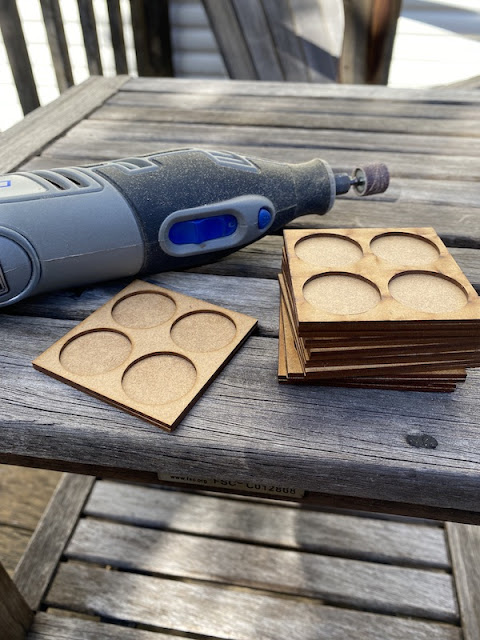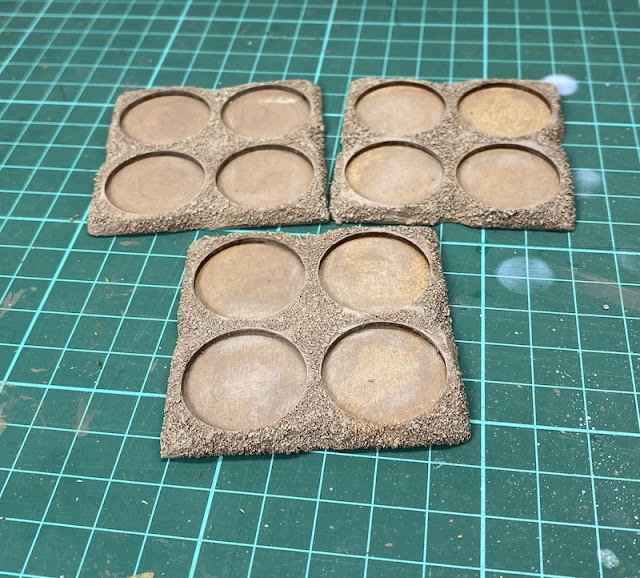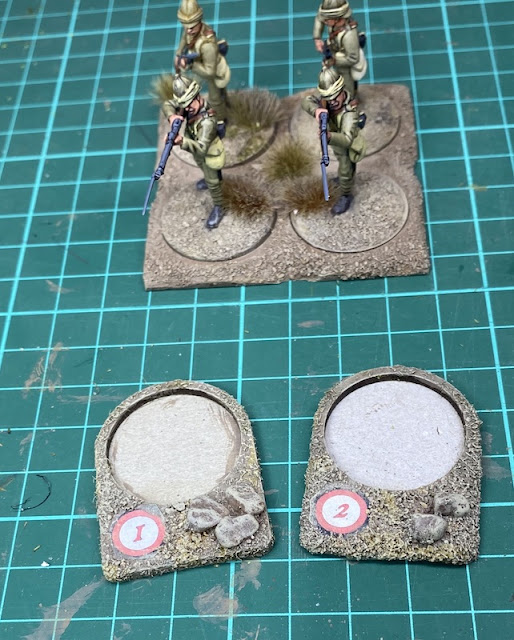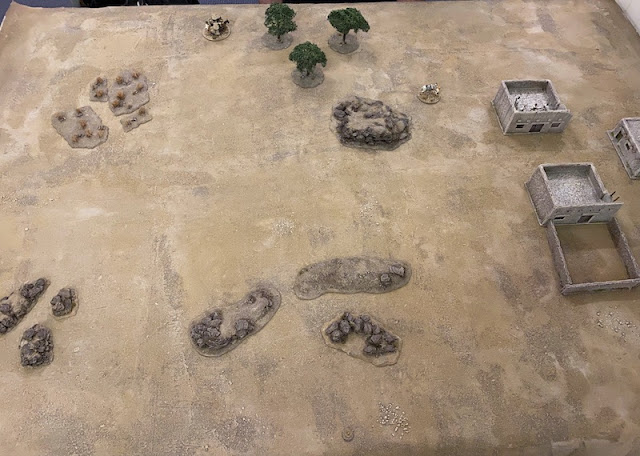I like the idea of terrain that can be versatile for different periods and locations. The trees I originally created for 20mm games in NW Europe are large enough to work for my 28mm AWI games in North America. The same trees have helped fill out my jungle terrain when playing 20mm Second World War games in the Far East yet also populated 28mm tables for the Hundred Years War. That sort of thing is not so straightforward once you move your games into the arid terrain of the desert. It means very few pieces will translate and so my recent venture into the Sudan has called for more terrain and game aids.

One of those are sabot bases. The ones I use currently were made for Sharp Practice in North America and won't work in the desert. While I find sabots useful for moving formations of figures I don't like the way they can appear on the table as raised platforms. It's probably just a personal thing but they do seem to break the immersion (I can't help thinking the miniatures look like they're performing on a stage). For me there's a simple enough solution which is to bevel the edges using the sanding attachment on my Dremel rotary tool.
It's just a matter of doing this freehand as you are after a naturalistic look.
What is remarkable is the difference it makes. I'm not sure if it's an optical illusion, but it's hard to believe the two bases pictured below are exactly the same thickness.
The next steps are to add texture and paint in exactly the same way as I do the figure bases. In the case of the desert they don't even require any flock other than the odd tuft.
I think they become much less obvious and intrusive once the figures are in place.
I'd hate to suggest that I'm fussy or obsessive about this (yeah, right, I hear you say) but I also dislike empty sabot slots during a game. Once again it breaks the illusion and the immersion, but there are several simple enough fixes which involve creative use of round bases. I use mini dice to record things like morale or shock and so having these the same size and style as the figure bases means they can be dropped quickly into a slot emptied by a casualty. Similarly I've made a few blank bases to perform an identical role.
The blanks are quick and easy enough to make and I think well worth the effort. Of course eventually the entire sabot can be removed from play once the number of casualties increases.
I've found that even the most experienced Sharp Practice players have a problem remembering which leader relates to which card or chit. I've found the easiest way to handle this is to create specific leader bases that show the number of the corresponding card and the leader's status level (represented by the appropriate number of rocks).
Naturally there is a matching set for each side and I've produced the same for the Dervish leaders.
In the Sudan variant for Sharp Practice Mahdist groups can often start the game with a certain amount of Fervour, which acts like shock but in a positive way. As I had a number of spare shields and weapons left over from the Perry plastic sets I thought I would make up themed markers for these. Once the fervour has been lost the groups take shock much like other units and so all I do is use a different coloured dice to indicate fervour and shock.
Lastly the Mahdists have the ability to Go to Ground and find a better level of cover. I wanted a simple themed marker to use for this and just added a few large rocks to a base to help record when a unit has done this.
Finding a basing system that works and a handful of game aids to keep track of action on the table can go a long way to keeping a game flowing and making it more enjoyable. So far I'm happy with what I've done for these games in the Sudan.
I didn't want to use sabot bases for the Mahdists, so they are based together in threes, twos or individually which allows for the look of a tribal mass while not appearing regimented. At the same time it enables quick movement of figures much like a sabot base. The 3,2,1 combination allows for casualty removal and I've found it very effective for basing units armed with edged weapons who tend to move en masse.
The leader figures are easy to identify and yet their basing blends in with the mass of other figures.
As does the marker used to record their fervour, or alternatively....
... their level of shock.
Similarly, it's clear to see when they've 'Gone to Ground'.
While I'm very much enjoying playing games set in the Sudan, like any new(ish) project it's called for the creation of more pieces of terrain. Having made a desert game mat the next project has been to build the terrain to populate it. The latest additions have focussed on trees, patches of scrub, and, a few more rocky outcrops.
At the same time as I created the desert mat I made several rocky outcrops like the one pictured below and you can see more about how I made them in this post.

After a couple of games I soon realised I didn't have enough. That led me to dig out a box of old terrain pieces and give them a revamp.
Several years ago I made areas of scrub for my 20mm games. Unfortunately I'd gone a bit overboard on the foliage for the scrub to the point that the pieces were not particularly functional, with figures balanced precariously on top of the vegetation.
I'd been tempted to dispose of them but as you never know when something might come in useful I'd stored them away. I thought with a little bit of work they could be transformed into rocky outcrops. So the first thing was to strip off the foliage. It was all re-usable and so I've stored it in a bag. Like I said, you never know when something will come in handy, even if it's not obvious at the moment.
I didn't bother removing all the static grass as it would soon be buried under filler, sand and paint. The bases were originally built up using insulation foam and so I cut into that and embedded pieces of dried bark, exactly the same material I had used in my original rocky outcrops. They were then blended into the terrain using filler.
The rest of the base was covered in PVA and a layer of sand. Extra small rocks were added using cat litter. Then they were painted to match the other pieces and the desert terrain mat.
Lastly a few small pieces of foliage were added sparingly using tufts.
There's a tendency to think automatically of palm trees when creating desert terrain but acacia trees also proliferate in those arid regions (their fruit being the principal ingredient of gum arabic). I had a few spare small tree armatures from
Woodland Scenics and so made an attempt at making them. The most distinctive features are the way their branches fan out and the way the foliage sits atop them.
The Woodland Scenics armatures can be bent and shaped in many different ways and so I spent a bit of time experimenting with various forms. Once I was reasonably happy I then shaped rubberised coconut fibre to the basic contours of the foliage.
I think the key is to try and get the foliage to look like it is perched on the top of the branches and not full like European type trees. I made a few adjustments before finally setting on the shape I wanted. Once done the final additions was miniature leaves from model railway scenery manufacturer
Noch.
The areas of scrub were simple enough to make. I cut small pieces from a coir door mat and placed them at irregular intervals on an MDF base. These were textured with sand and small clumps of rocks (in this instance aquarium pebbles). The rocks were picked out in a darker colour in much the same way as I paint those on the rocky outcrops.
Everything was then tied together with a good dry brush to match the other terrain pieces.
Last, but not least, the most important part - using them in a game. Here are a few of the various pieces in a recent game.









































Really nice work. I love your attention to detail.
ReplyDeleteThanks Carole.
DeleteIt all looks rather nice!
ReplyDeleteWow! That must have been a lot of work but it does all look fantastic and will make the games a real visual feast. I would not be surprised to see this in a wargame magazine.
ReplyDeleteThanks. To be honest the Dremel makes it a lot easier but I always thinks the reward comes in the difference it makes to the look of a game.
DeleteLovely as always, thanks for sharing. For the 12mm Victrix infantry, I shaved down the edge of the MDF base, but used a knife and the a light rub with sand paper (outside because the dust is not good for you). It does make a big difference compared to the ‘shelf’ look.
ReplyDeleteYes, noticed that with my 12mm basing and wish I'd done the same. I thought I'd used fairly thin plastic but when the figures are only 12mm high it is very noticeable.
DeleteBrilliant stuff. I have never thought to bevel movement trays but I do use blanks as you do to cover empty holes.
ReplyDeleteAll the terrain and markers painted in a consistent manner really do tie the whole table together in a way that compounds the effect and tremendously increases the appearance of the game. 😀
Thanks Stew. I'd say bevelling edges of bases for figures and terrain is one of the major work outs for the Dremel, but I do like the final look.
DeleteA big fan of your terrain and all camouflaged markers and sabots - but still think those acacia trees look a bit too deep a green?
ReplyDeleteThanks. The lighting on my work bench has probably over enhanced the green of the foliage but you could be right. I have some lighter coloured leaves and they may need an additional sprinkling of those.
DeleteVery effective...looks great on the table!
ReplyDeleteThanks Jim.
DeleteVery nice. Have to try this.
ReplyDeleteThanks. It's a bit of effort (not to mention dusty) but I think it's worth it.
DeleteNice work on the terrain pieces and the little details, added to the movement trays for the troops and dice for Shock.
ReplyDeleteThanks John. I think you and I are much alike when it comes to this - it's the little details that count just as much as the big terrain pieces.
DeleteWith you all the way on this! Empty sabot slots just irk me. I’ve made a number of “scenic blanks” to fill the gaps. I have numbered base-rings for my leaders, and your bases with added rocks for levels are smashing. I’m also very into the idea of terrain being very multi-purpose. The chamfered movement trays are a neat trick too.
ReplyDeleteCheers
Matt
Thanks Matt. I agree, I think if people are going to go to the effort of using lovely painted miniatures and beautiful terrain why spoil it with empty sabot slots?
DeleteAhh....the Sudan something I can not be tempted into! Nice work on the terrain.
ReplyDeleteI resisted for some time, but succumbed in the end! Glad I did.
Delete